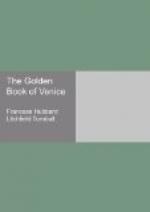The Veronese had a gift of sympathy; his heart opened to those who loved art and had conquered difficulties in her service, and the talk flowed freely. “I believe,” he said, as together they laid away the parchment, “that in our modern mosaics we should keep to the massive lines of these earlier models—greater dignity and simplicity in outline and coloring. It is a mistake to attempt to confound this art with painting.”
“It is good, then, for our art, Messer Cavaliere, that at San Donato, our mother church, we workmen of Murano have our Lady in that old Byzantine type; there is none earlier—nor in all Venice more perfect of its time—and the setting is of marvelous richness and delicacy.”
“It is most interesting,” said the Veronese. “Sometimes a question has come to me, if an artist cannot do the all, is he most the artist who stops below his limitation or beyond it? A question of the earlier hint, or the later realization.”
“Between the mosaic and the painting, perhaps?” Girolamo questioned, greatly interested.
“Nay, not between the arts, but of that which is possible to each. It is not a Venetian question. Here all is warmth, color, beauty, joy; here art is the expression of redundancy—it hath lost its symbolism.”
“I know only Venice—the Greek and the Venetian types. But I have heard that the Michelangelo was in himself a type?”
“He was a prophet,” the Veronese answered reverently, “like the great Florentine—a seer of visions; but at Rome only one understands why he was born. He was a maker, creating mighty meanings under formlessness. His great shapes seem each a mystery, wrestling with a message.”
“I had thought there was none who equaled him in form—that he was even as a sculptor in his painting.”
“And it was even so. When I spake of ‘formlessness’ it was not the less, but the more; as if, before the visions had taken mortal shape, he, being greater than men, saw them as spirits.”
“Never before have I talked with one who knew this master,” said Girolamo, “and it is a feast.”
“Nay, I knew him not, for it was not easy to get speech with him, nor a favor a young man might crave. But once I saw him at his work in San Pietro, where he wrought most furiously and would take no payment—’for the good of his soul,’ he said, that he might end his life with a pious work. The night was coming on, and already his candle was fastened to his hat, that he might lose no time. They had brought him a little bread and wine for his evening meal, for often he went not home when the mood of work possessed him; and beside him was a writing of the man Savonarola—this and the Holy Evangel and the ‘Inferno’ fashioned his thoughts. He lived not long after that, for we were still in Rome when they made for him that great funeral in Santa Croce of Florence, the rumor of which is dear to artist hearts. He was great and lonely, and he knew no joy; there hath been none like him.”




